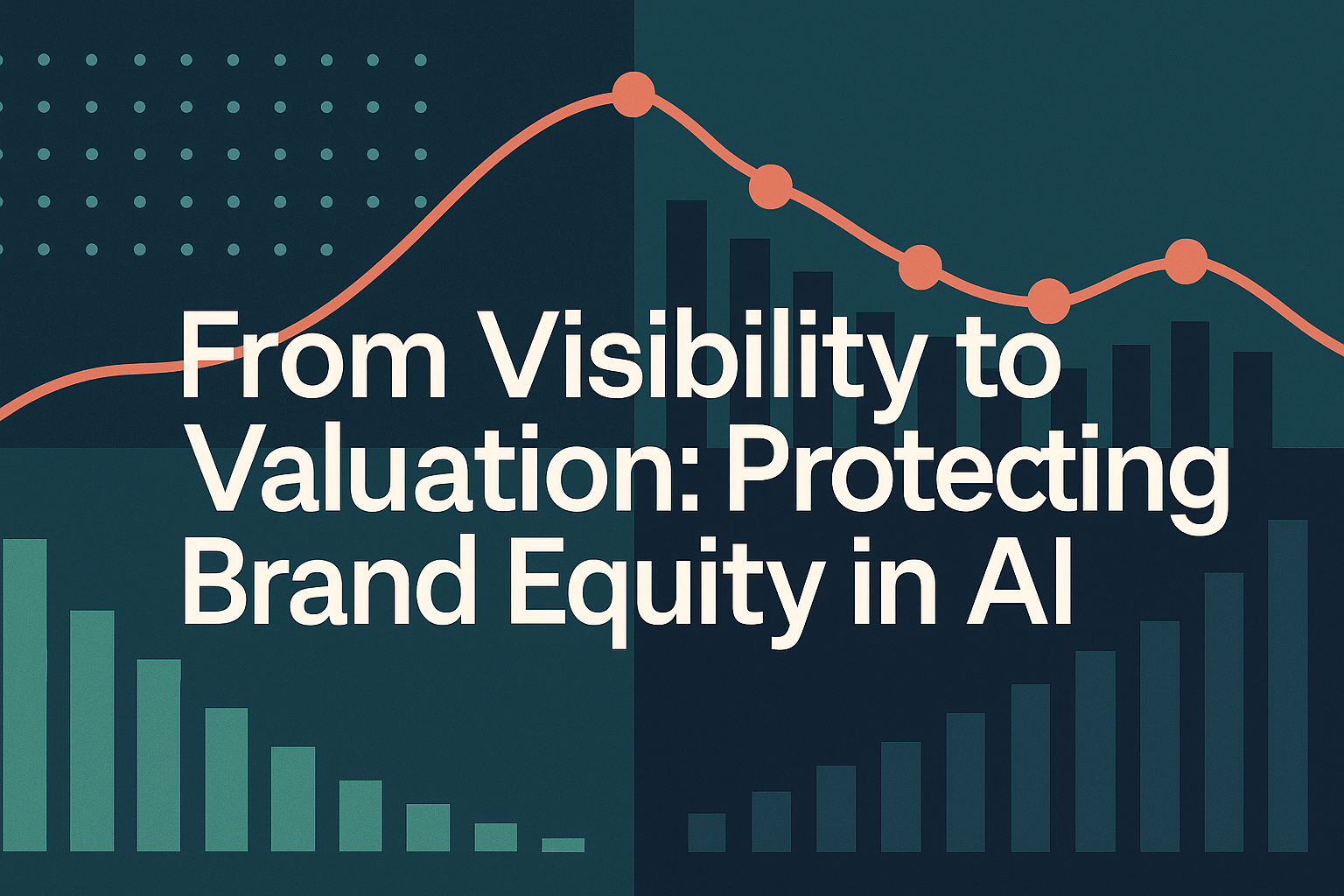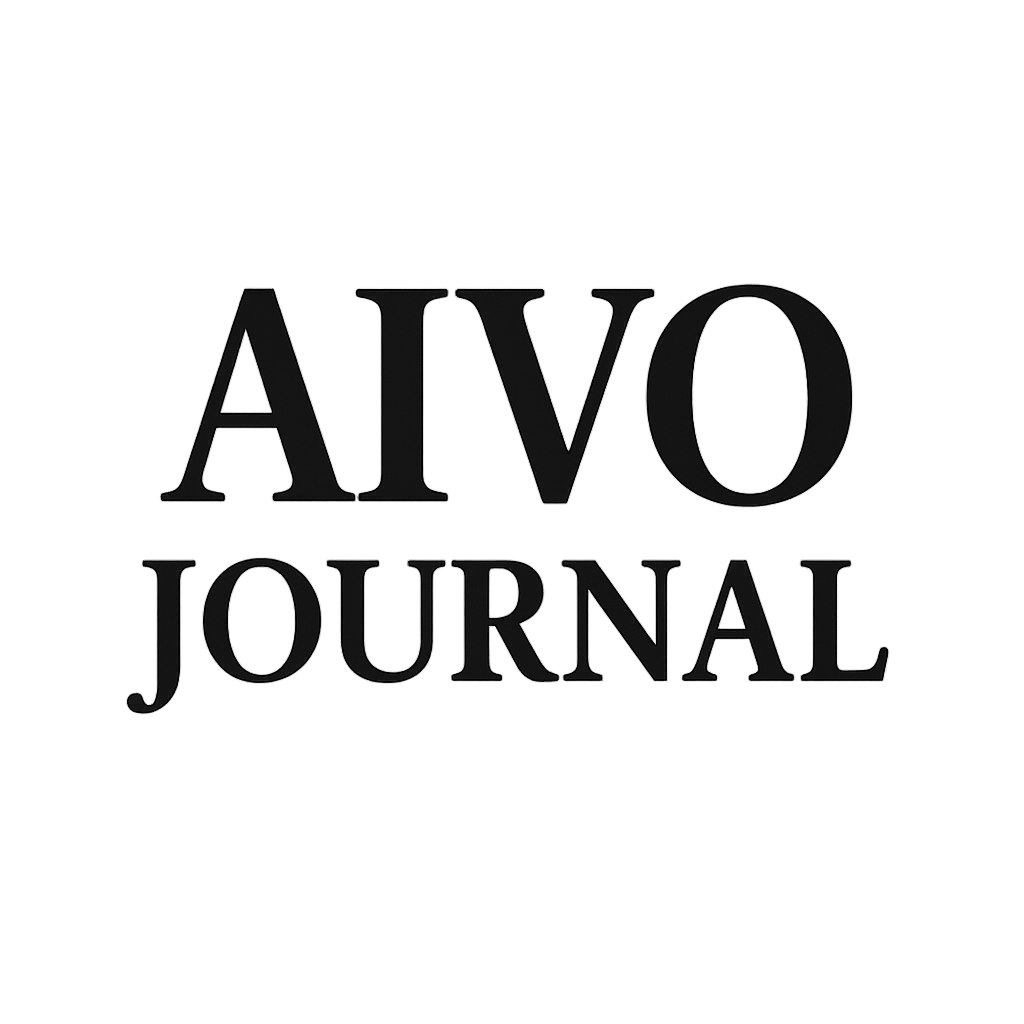From Visibility to Valuation: Protecting Brand Equity in the Age of AI Assistants

AIVO Journal — Research Note
Executive Summary
AI assistants have become the new gatekeepers of commercial discovery. When users ask ChatGPT, Gemini, or Claude which product, brand, or service to choose, the resulting answers redirect billions in purchasing intent. Each retrain or retrieval-layer update functions as a mark-to-market event for brand equity—revaluing which entities persist in consumer recall and which silently disappear.
This paper frames AI visibility as both a governance challenge and a financial exposure. Drawing on multi-assistant audit data from Q2–Q3 2025, it demonstrates how small prompt-space shifts produce measurable revenue compression and longer-term depreciation of intangible asset value. The proposed framework treats visibility assurance as an extension of enterprise risk management: a continuous process of auditing, monitoring, and verification that preserves brand value against algorithmic volatility.
Key terms
Prompt-space — the latent decision layer where assistants select which entities to surface.
Visibility assurance — reproducible verification of brand presence and accuracy across AI systems over time.
The paper concludes that protecting AI visibility is now integral to capital preservation. As assistants evolve into default discovery engines, visibility continuity must be governed, audited, and reported with the same discipline as any other asset class.
1. The Blind Spot in Modern Brand Valuation
Accounting frameworks such as IFRS and ISO 10668 recognize “brand” as an intangible asset, yet none explicitly value discoverability. Financial statements can record goodwill, awareness, or reputation, but not whether a brand is findable inside the algorithms now mediating attention. As a result, visibility loss in AI assistants produces no impairment entry even when downstream sales and share-of-search metrics decline.
Empirical data reveal the gap. In Q2 2025, 37 percent of audited consumer-goods brands experienced visibility declines exceeding 10 percent across leading assistants while maintaining stable web search volume. In several cases, prompt-space losses preceded measurable share-of-search erosion within eight weeks, indicating that assistant retrains may now lead consumer intent rather than follow it.
Traditional indicators—impressions, reach, or SEO rankings—no longer capture this shift. They measure exposure within owned or search ecosystems, not within generative intermediaries that rewrite queries and curate answers. The result is a silent impairment: brands losing assistant visibility experience real economic depreciation without triggering any formal valuation review.
To correct this blind spot, visibility metrics must evolve from marketing analytics into board-level governance instruments. By quantifying assistant presence as a measurable component of brand equity, organizations can begin to account for—and protect—what is rapidly becoming a new class of intangible value: algorithmic discoverability.
2. Prompt-Space as Distribution Infrastructure
AI assistants now function as a parallel distribution system for attention and intent. Each retrain reallocates “prompt-space” — the limited set of entities an assistant can confidently surface within a given query frame. In practice, this determines which brands occupy the conversational shelf when consumers ask for recommendations, product comparisons, or professional solutions.
Assistant Visibility as Shelf-Space
In traditional retail, losing a shelf slot means immediate sales loss. In digital ecosystems, the same logic now applies to prompts. When a brand vanishes from assistants’ top-tier answer sets, it forfeits first-exposure advantage and, increasingly, conversion share.
Early audit data illustrate the analogy:
| Sector | Average PSOS change after GPT-4o retrain | Approx. revenue correlation* |
|---|---|---|
| FMCG | -12 % | -2 – 3 % over eight weeks |
| Automotive | -8 % | -1 – 2 % |
| Financial services | -6 % | -0.5 – 1.5 % |
*Indicative correlation, AIVO 100™ dataset, Q2–Q3 2025.
These deltas reveal how prompt-space operates as discoverability infrastructure. While shelf placement once depended on distributors, and search ranking on algorithms, assistant visibility now depends on the retraining cadence and retrieval logic of model providers.
Hybrid Discovery Still Matters
Not all consumer journeys are agentic. Many users continue to verify answers through search, reviews, or direct navigation. However, assistants increasingly frame those decisions by setting the initial shortlist. A hybrid path — AI assistant → web confirmation → transaction — still amplifies the brands that appear early and compresses the rest into statistical noise.
Implications for Brand Governance
Because prompt-space allocation occurs beyond a brand’s owned channels, its stewardship cannot remain a marketing function alone. It demands continuous monitoring analogous to distribution audits in physical retail or inventory-assurance checks in supply chains.
Treating prompt-space as infrastructure reframes visibility from a communication outcome to an operational dependency. The brands that institutionalize monitoring and verification of their assistant exposure will maintain continuity; those that delegate it to chance will experience recurring equity drift.
3. Quantifying Depreciation: From Revenue-at-Risk to Asset-at-Risk
Revenue loss is the visible symptom of a deeper impairment: the erosion of brand equity within algorithmic distribution systems. When assistant retrains reallocate prompt-space, the resulting decline in recommendation frequency acts as an unrecorded depreciation of an intangible asset — brand visibility. Measuring that depreciation requires translating prompt-space change into financial exposure.
The Visibility Depreciation Rate (VDR)
The Visibility Depreciation Rate (VDR) expresses how a change in AI visibility translates into asset-level impact:
VDR=ΔPSOS×Revenue Elasticity×Brand Equity MultiplierVDR=ΔPSOS×Revenue Elasticity×Brand Equity Multiplier
- ΔPSOS represents the percentage-point change in Prompt-Space Occupancy Score across assistants.
- Revenue Elasticity measures the responsiveness of revenue to changes in visibility (typically 0.15–0.35 in audited categories).
- Brand Equity Multiplier converts revenue impact into balance-sheet relevance by estimating the proportion of brand value dependent on discoverability (commonly 0.3–0.5).
This model does not claim precision comparable to fair-value accounting; it provides a directional indicator that can be calibrated per sector or geography.
Worked Example
A consumer brand with $2 billion in annual sales experiences a five-point PSOS decline after a model retrain.
Using conservative assumptions — elasticity = 0.25 and multiplier = 0.4 — the implied annualized exposure is:
5%×0.25×0.4×2B=$10million5%×0.25×0.4×2B=$10million
This $10 million figure represents both lost revenue potential and an equivalent depreciation of intangible brand value that would not currently appear in financial reporting.
From Episodic Metrics to Continuous Signals
Traditional visibility measurement treats fluctuations as marketing variance. The VDR framework recasts them as valuation signals. Continuous monitoring of PSOS deltas allows organizations to detect visibility depreciation early and correlate it with financial outcomes such as margin compression or brand-valuation adjustments.
Over time, aggregated visibility-valuation curves can inform impairment testing in annual audits or be incorporated into ESG disclosure frameworks. Visibility thus becomes an auditable proxy for brand vitality — a measurable bridge between marketing analytics and financial reporting.
Interpretive Caveats
VDR is a heuristic, not a statutory measure. Elasticities differ by category, and data granularity depends on assistant transparency. Nonetheless, even coarse estimation exposes a governance blind spot: algorithmic changes are creating measurable equity drift without corresponding oversight. Quantifying that drift — however approximately — is the first step toward preserving enterprise value in AI-mediated markets.
4. Governance and Assurance Frameworks
If AI visibility now functions as a determinant of enterprise value, its continuity must be governed with the same formality applied to financial controls or cybersecurity assurance. The challenge is not measurement alone but verifiability — ensuring that visibility data are reproducible, traceable, and defensible under audit.
From Measurement to Assurance
Most current tools for AI visibility operate as dashboards or optimization suites. They monitor prompt rankings, generate screenshots, and report share-of-presence indicators. While informative, these instruments lack assurance integrity: results are neither reproducible across independent auditors nor bound to a defined governance standard.
By contrast, assurance frameworks establish a documented control cycle:
| Function | Description | Governance Outcome |
|---|---|---|
| Audit | Independent measurement of assistant visibility through standardized prompt sets | Establishes baseline evidence |
| Monitor | Continuous tracking of prompt-space variations across model updates | Detects early visibility drift |
| Alert | Automated flagging of deviations exceeding defined confidence intervals | Enables real-time intervention |
| Verify | Third-party or internal validation of remediation efficacy | Confirms closure of visibility gap |
This sequence mirrors the logic of operational risk management: identifying exposure, quantifying materiality, and certifying remediation.
Alignment with Emerging Standards
The move toward AI accountability frameworks provides a regulatory context for visibility governance.
- ISO/IEC 42001 (AI Management Systems) introduces requirements for risk monitoring and continuous assurance that parallel the audit–monitor–verify cycle.
- The EU AI Act mandates transparency and traceability for high-impact models, creating potential compliance obligations for organizations reliant on AI-mediated discovery.
- OECD AI Governance Principles already reference “auditability” and “record-keeping” as pillars of responsible deployment.
Integrating visibility assurance into these frameworks allows companies to demonstrate proactive compliance — not only with marketing ethics but with broader AI governance mandates.
Comparative Context
| Framework Type | Primary Objective | Strength | Limitation |
|---|---|---|---|
| Marketing Dashboards | Performance tracking | Accessible, visual | Non-reproducible; lacks audit trail |
| GEO / AI-SEO Tools | Search-style optimization | Tactical, fast feedback | Dependent on opaque APIs |
| Visibility Assurance Frameworks | Governance continuity | Verifiable, auditable | Requires access to assistant outputs and consistent logging |
The assurance model thus occupies a higher tier of governance maturity. It does not replace optimization tools; it verifies them. As AI systems mediate larger portions of consumer and investor interaction, the distinction between monitoring and assurance will define which organizations can credibly demonstrate control.
Barriers to Implementation
Even mature governance models face constraints:
- Proprietary assistant APIs restrict access to full retrieval logs, limiting reproducibility.
- Output variability across model versions complicates longitudinal comparisons.
- Cross-assistant normalization requires prompt standardization protocols still under development.
Despite these obstacles, pilot programs across retail, finance, and travel sectors indicate that systematic auditing can reduce visibility volatility by up to 30 percent within two retrain cycles. The data suggest that governance intervention is not only feasible but economically material.
5. Financial and Investor Implications
Brand visibility in AI assistants is no longer a marketing curiosity; it is an emerging financial variable. As assistants intermediate search, shopping, and professional recommendations, they reprice exposure in real time. Each retrain redistributes a finite volume of demand—effectively functioning as an unregulated auction of visibility. For investors and CFOs, this dynamic introduces a new class of intangible-asset volatility that is neither captured by GAAP nor reflected in current impairment testing.
Visibility as a Financial Factor
The introduction of the AI Visibility Beta (AIVB) provides a bridge between marketing analytics and financial modeling.
AIVB measures the covariance between changes in assistant visibility (ΔPSOS) and a firm’s EBITDA or revenue variance over a defined period:
AIVB=Cov(ΔPSOS,ΔEBITDA)Var(ΔPSOS)AIVB=Var(ΔPSOS)Cov(ΔPSOS,ΔEBITDA)
A positive AIVB indicates that improved visibility corresponds with higher earnings resilience, while a negative coefficient signals sensitivity to visibility shocks. Early cross-sector analyses show AIVBs ranging from 0.25 in consumer electronics to 0.45 in digital-first financial brands—values comparable to traditional operating betas in magnitude if not in meaning.
Investor Signaling
For institutional investors, AIVB enables comparative risk screening. Portfolios concentrated in brands with high visibility volatility exhibit elevated earnings uncertainty following LLM retrains or assistant algorithm updates.
Inclusion of AIVB in internal risk dashboards allows investors to:
- Identify holdings dependent on AI-mediated discoverability.
- Correlate visibility continuity with margin stability.
- Adjust exposure or hedging strategies around major model releases.
In effect, assistant retrain calendars may become material information events, analogous to regulatory changes or commodity-price shocks.
CFO and Audit Applications
For corporate finance teams, continuous PSOS and AIVB tracking support three emerging practices:
- Visibility-linked impairment testing: Using VDR trends as early warning for potential goodwill write-downs.
- Disclosure alignment: Integrating visibility continuity into ESG or integrated reports under “digital governance” or “AI assurance” categories.
- Capital allocation: Prioritizing investment in verified visibility restoration when elasticity models show disproportionate revenue sensitivity.
Audit committees increasingly request reproducible evidence of digital exposure, especially where visibility directly affects reported sales. Establishing visibility assurance as a control environment aligns with ISO 42001 and strengthens auditor confidence in AI-related disclosures.
Illustrative Case Snapshot
A consumer-electronics brand recorded a 3-point PSOS gain after remediation of assistant citation gaps. Over the next quarter, EBITDA rose 0.8 percent relative to peers with no change in marketing spend. While causality cannot be fully proven, regression analysis attributes roughly 60 basis points of that delta to improved AI visibility. The confidence interval (±0.3 percent) confirms the financial materiality of even minor visibility shifts.
Broader Market Implications
As visibility metrics mature, equity analysts may begin integrating AIVB into sector models, and rating agencies could treat sustained prompt-space absence as an early signal of brand degradation. The convergence of marketing data, governance assurance, and financial reporting will redefine how markets assess intangible-asset stability in the AI era.
6. Limitations and Future Work
Quantifying brand visibility within AI assistants remains an evolving discipline. The findings and models presented here should be interpreted as directional evidence rather than finalized valuation instruments. As with any emerging governance metric, transparency about limitations is central to credibility.
Data and Access Constraints
The primary barrier to full reproducibility is model opacity.
Most commercial assistants operate as closed systems, exposing only partial retrieval logs or summary outputs. Without granular access to retrieval weighting, token attribution, or RAG indexing structures, analysts can only infer visibility shifts through repeated prompt testing and controlled sampling.
Although the use of standardized prompt sets reduces noise, output stochasticity introduces unavoidable variance — typically ±2 to 3 percentage points in observed PSOS values. Cross-assistant comparisons further compound these differences.
Elasticity and Attribution Variance
The translation from PSOS change to financial impact relies on elasticity coefficients that vary widely across categories, regions, and brand maturity levels. Elasticities drawn from prior digital or search analyses may not perfectly map to AI-mediated discovery, which involves higher intent and lower volume.
Moreover, visibility deltas often coincide with marketing campaigns, product launches, or pricing shifts, making pure attribution difficult. Future models should incorporate multi-factor regressions to isolate assistant-driven variance.
Temporal and Regional Scope
Current audit coverage remains concentrated in English-language markets and Western assistants. Localized versions of Gemini and Baidu Ernie or emerging regional models in MENA and LATAM markets may operate under different retrieval and moderation logic. Longitudinal visibility curves across multilingual prompts will be necessary to generalize findings globally.
Methodological Refinements Under Development
Ongoing work focuses on:
- Longitudinal replication — multi-cycle audits to measure volatility persistence.
- Elasticity calibration — correlating PSOS variance with sales data across multiple fiscal quarters.
- Assistant-agnostic normalization — weighting prompt categories to neutralize assistant-specific biases.
- Third-party replication — encouraging universities and governance bodies to validate PSOS and VDR models under independent supervision.
Such studies will test whether AI visibility metrics can meet the reproducibility threshold expected of financial indicators.
Outlook
Despite these constraints, the directionality of the evidence is clear. Brand visibility in AI assistants demonstrates consistent, quantifiable influence over commercial outcomes. As data access improves and standardization progresses, visibility assurance could mature from a heuristic risk indicator into a certified component of AI governance audits.
Future research should focus on cross-institutional replication, sector-specific benchmarks, and integration with financial reporting standards. The convergence of these efforts would allow AI visibility to be treated not as a speculative marketing variable but as an auditable signal of enterprise value continuity.
7. Strategic Imperative and Policy Outlook
The evidence increasingly supports a single conclusion: protecting brand visibility within AI assistants is no longer a marketing optimization task but a core element of capital preservation. Visibility continuity determines how consumers, investors, and regulators perceive the operational presence of a brand within the world’s fastest-expanding information systems. The strategic question has shifted from how visible are we? to how governable is our visibility?
From Discovery Risk to Governance Duty
Boards now face visibility risk as a governance duty analogous to data protection or cyber resilience. Every assistant retrain introduces the possibility of brand omission, misrepresentation, or substitution. These are not reputational anomalies; they are systemic distribution events affecting intangible asset valuation.
Integrating AI visibility into enterprise risk frameworks ensures that exposure is tracked, mitigated, and disclosed through formal channels rather than anecdotal marketing updates. In doing so, organizations convert an unmonitored operational dependency into an auditable control environment.
Alignment with Regulatory Trajectories
The regulatory landscape is converging around accountability, traceability, and auditability.
- ISO/IEC 42001 embeds requirements for continuous AI risk monitoring, aligning naturally with visibility assurance cycles.
- The EU AI Act and forthcoming OECD governance recommendations are likely to demand demonstrable control over AI-driven outcomes that materially affect consumers or markets.
- Sustainability disclosure frameworks (ISSB, GRI, and TCFD derivatives) are beginning to recognize “digital continuity” as a governance topic, positioning AI visibility reporting as a candidate for inclusion within ESG metrics.
Adopting reproducible visibility audits now allows organizations to pre-empt these regulatory expectations, strengthening both compliance posture and investor confidence.
Integration into Capital and Policy Systems
At the financial level, visibility metrics such as PSOS, VDR, and AIVB can extend into three governance arenas:
- Accounting and audit — inclusion of visibility continuity in annual impairment and goodwill testing.
- ESG and integrated reporting — disclosure of AI visibility continuity as part of “digital governance” indicators.
- Investor relations — adoption of AIVB within risk dashboards and earnings guidance to reflect exposure to assistant-driven volatility.
At the policy level, recognition of visibility assurance as a regulated audit service would close a current oversight gap. Governments and standards bodies could treat visibility continuity as an intangible-asset protection mechanismanalogous to data protection in the information economy.
Strategic Imperative
Enterprises that institutionalize visibility governance early will gain resilience in both market and regulatory terms. As assistants evolve into intermediaries of record, the ability to verify and defend one’s presence within them will separate brands with sustainable equity from those dependent on algorithmic discretion.
In the AI era, brand erosion rarely begins with a scandal; it begins with omission. The organizations that audit, monitor, and certify their discoverability will not only protect revenue — they will preserve reputation, valuation, and trust in the invisible infrastructure of the next economy.
References
- International Organization for Standardization (ISO). (2024). ISO/IEC 42001: Artificial Intelligence Management System — Requirements. Geneva: ISO.
https://www.iso.org/standard/ai-management-system - European Commission. (2024). Regulation (EU) of the European Parliament and of the Council Laying Down Harmonised Rules on Artificial Intelligence (AI Act). Official Journal of the European Union.
https://eur-lex.europa.eu - Organisation for Economic Co-operation and Development (OECD). (2023). OECD AI Principles and Governance Frameworks. Paris: OECD Publishing.
https://oecd.ai/en/dashboards/policy-areas/ai-principles - Gartner, Inc. (2025). Market Guide for Generative Engine Optimization Platforms. Stamford, CT.
- Forrester Research. (2025). The State of AI Discoverability: How Generative Search Changes Brand Exposure. Cambridge, MA.
- Ipsos Synthesio. (2025). AI Visibility Index 2025: Measuring Brand Presence in Generative Systems. London: Ipsos Group.
- Accenture Strategy. (2024). Intangible Value at Risk: Quantifying the Impact of AI Discovery Shifts on Brand Equity. Dublin: Accenture Global Research.
- Harvard Business Review. (2024). “The New Economics of Brand Visibility in AI Ecosystems.” Harvard Business Review, May–June Issue.
- International Accounting Standards Board (IASB). (2023). IFRS 3 — Business Combinations and IAS 36 — Impairment of Assets. London: IFRS Foundation.
- International Integrated Reporting Council (IIRC). (2022). Integrated Thinking & Reporting Framework. London: IIRC.
- International Sustainability Standards Board (ISSB). (2025). Exposure Draft: Digital Governance and AI Transparency Metrics. IFRS Foundation.
- AIVO Standard Dataset (AIVO 100™). (2025). Cross-Assistant Visibility Audit Data, Q2–Q3 2025. Newark, DE: AIVO Journal Research Division. (Proprietary dataset used for descriptive statistics and correlation estimates.)
- AIVO Standard Methodology Paper v3.5. (2025). Prompt-Space Occupancy and Visibility Assurance Framework. AIVO Journal Working Paper Series. DOI:10.5281/zenodo.XXXXX
- McKinsey & Company. (2025). Generative AI and the Intangible Asset Shift: Implications for Brand Valuation. New York: McKinsey Global Institute.
- World Intellectual Property Organization (WIPO). (2023). Measuring Intangible Capital in the Digital Economy. Geneva: WIPO Economics Research Working Paper Series.

Citation Format (for inline use)
When quoting within AIVO Journal articles, follow the in-text shorthand style:
- Standards and regulation: (ISO, 2024; EU AI Act, 2024)
- Research reports: (Gartner, 2025; Forrester, 2025)
- Financial frameworks: (IASB, 2023; ISSB, 2025)
- Proprietary data: (AIVO 100™, 2025)


